What is Mohenjodaro?
There has been a lot of questions regarding the title Mohenjo-Daro. Here's the answer.
The film is based on the probably the oldest urban Civilization in the world which existed from 4000-800 BC (dates are a matter of debate among scholars with this being the most agreed upon).The prime of the Civilization was around 2000-1500 approx.The Civilization like most others had Urban as well as Rural areas .The civilization flourished on the banks of rivers Sindhu(better known as Indus) and the now dried up river Saraswati or Ghaggar-Hakkar. The most well known urban settlements identified till now are Harappa and Mohenjo-Daro(in Present day Punjab and Sindh region of Pakistan) . Other identified urban settlements are Ganeriwala (present day Indo-Pak border) , Dholavira (in present day Kutch,Gujarat,India) , Rakhigari (in present day Haryana,India) and a host of others.
The names of these sites are given by the archaeologists and historians who worked on these sites and are not actual names.The city of Mohenjo-Daro (meaning Mound of Dead ) was given as supposedly a heap of skeletons were found at a single place in the site.The name has been popular and is well known among general public.Although the name is a derogatory one it's well accepted among history scholars and public.The actual name is relatively unknown as the script hasn't been deciphered yet.There have been analogies with Brahmi and Late -Elamite Scripts and similarities have been found but it isn't an established fact.A probable name suggested is Kuku-Tarma but it isn't sure enough too.The people of the civilization are widely known as Harappans on the name of another well known city.
So, the bottom line is the makers decided to make the film , with a well known city of the civilization as it's base and the title they chose was a name which is well known to everyone.
Questions Regarding Clothing
There have been a lot of questions regarding the clothing used in thefilm.There's no written records of the clothing used in that era.So, it's all based on artifacts and guess work.
Textiles are rarely preserved and the figurines are usually unclothed, so there is not much evidence of Harappan clothing. Small fragments of cloth preserved in the corrosion products of metal objects show that the Harappans wove a range of grades of cotton cloth. Flax was grown and may have been used for fibres (alternatively it was grown for its oilseed). Native Indian species of silkworm may have been utilised for silk (inferior to Chinese silk), as they were a little later in South Asia. It is not known whether the Harappans raised woolly sheep, but their trade with Mesopotamia probably brought them abundant supplies of Mesopotamian woolen textiles. The Harappans also probably continued the earlier tradition of making clothing from leather. Dyeing facilities indicate that cotton cloth was probably dyed a range of colours, although there is only one surviving fragment of coloured cloth, dyed red with madder; it is likely that indigo and turmeric were also used as dyes.
The limited depictions of clothing show that men wore a cloth around the waist, resembling a modern dhoti and like it, often passed between the legs and tucked up behind. The so-called "Priest-king" and other stone figures also wore a long robe over the left shoulder, leaving bare the right shoulder and chest. Some male figurines are shown wearing a turban. Woman's clothing seems to have been a knee-length skirt. Figurines and finds in graves show that Harappans of both sexes wore jewellery: hair fillets, bead necklaces and bangles for men; bangles, earrings, rings, anklets, belts made of strings of beads, pendants, chokers and numerous necklaces for women, as well as elaborate hairstyles and headdresses. Jewelry was generally made from gold, silver, copper, and a range of semi-precious stones.Jewels were used among richer sections of the society.
"Indigofera tinctoria", a shrub of a plant with purple flowers was an ancient source of an Old World blue dye known as "indigo." The earliest example of indigo from Indigofera probably comes from the Bronze Age Indus Valley Civilization, cultivated along the banks of the Indus River. The ancient civilizations of Harappa and Mohenjo Daro fermented the leaves of indigofera to create a blue cake-like powder that was a natural dye for cotton. They were not just farmers but also merchants who traded indigo with the other great civilizations of the time. When the town of Rojdi (a site that was part of the Indus Valley civilization) was excavated, archaeologists recovered seeds from at least 4 different species of the genus Indigofera. Archaeologists also recovered remnants of cloth dyed blue from Mohenjo Daro that dated to 1750 BC.
The Dress Of Chaani played by Pooja Hedge
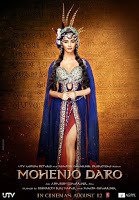

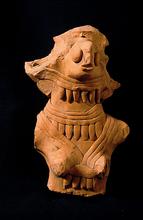
- An elegant hairstyle along with elaborate headdress ( which has been found out to be quite common in figurines excavated) The primary colours used are Blue(Indigo) and Red. As, it has been suggested Indigo farming was done extensively by the Harrapans and natural dyes were used.So, it can be guessed easily that Blue and Red would have been the primary colours along with others. The breast plate is studded with gems. As, discussed above jewels were extensively used among wealthier sections of the society.
- The long designer dress. As, research suggest the clothes were wrapped in a variety of ways and this could be one variant. Although figurines of the supposed mother goddess like the ones below suggest a different type of dressing. It can't be said that there was no other way of dressing.

- However, the makers decided to give a tribute to these figurines by creating a similar one in the film.
The Dress of the character Maham played by Kabir Bedi
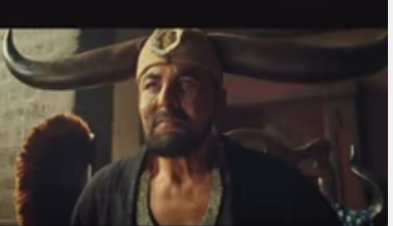
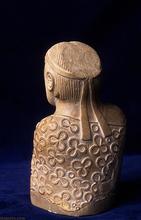
- The horns on his head can be attributed to the fact that Gods were often depicted in Indus Seals with horns in yogic postures and he considers himself as a demi-god as he says "I am the one who decides what happens in this city".


The Dress Of Sarman Played by Hrithik Roshan
Other striking similarities are use of Turbans and Dhotis in the trailer which are considered to be apart of the clothing then.
The Use of Horses
There have been complaints about use of horses in the trailer.
Here's a report by a renowned historian.
According to SK Gupta the horse (Equus caballus) "was widely domesticated and used in India during the third millennium BC over most of the area covered by the Indus-Sarasvati (or Harappan) Civilisation. Archaeologically this is most significant since the evidence is widespread and not isolated." Nothing in this assertion is correct, even if " or rather because " it comes from an archaeologist and inventive rewriter of history, S.P. Gupta. For example, the horses found in the early excavations at Mohenjo-Daro and Harappa do not come from secure levels and such 'horse' bones, in most cases, found their way into deposits through erosional cutting and refilling, disturbing the archaeological layers.
There's another theory that Horse was unknown to the people of Indus Valley and they were massacared by So, called Aryans who came mounting on horse back.
So, it's upto you which theory to believe.
The Fair Skin Debate
There have been complaints that the people of Mohenjodaro or rather the Indus Valley Civilization were of Dravidian Origin.So, they should have darker complexion.
The ones who are complaining this are the same people who complain on getting stereotyped in films when they are shown people from South India are shown to be of dark complexion.So, this isn't much of a debate in my opinion.( No Offence to anyone)
The Use Of lipstick and waxed Skin
I have seen a few complaints about use of lipstick by Chaani in thetrailer.Well, there have been evidences that cosmetics were used by women in that era.Waxed Skin..Really ?? The heroine already has a waxed skin ..Will she grow hair..??
The Film being a love story
The makers are making a commercial Bollywood film not some documentary on Indus Valley Civilization.So, there has to be commercial elements.It can't be entirely based on rise and fall of the civilization as suggested by some as the civilization spanned over 3000 years.It seems the film is based on the fag end of the civilization as we can see a flooding in the end of the trailer.Thereare theories that the civilization declined due to devastation caused by flooding of the Indus - Saraswati Valley which also resulted in drying of the Saraswati River later.
A few other examples of historical authenticity in the film
The Famous Unicorn Seal

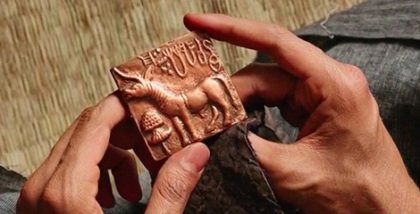

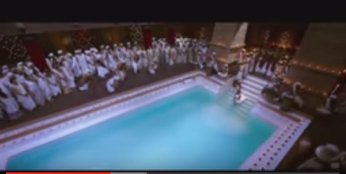
Thanks For reading this and hope all your doubts are cleared.
References
https://en.wikipedia.org/wiki/Indus_Valley_Civilisation
https://www.harappa.com/slideshows/around-indus-90-slides
https://www.harappa.com/har/indus-saraswati.html
http://archaeologyonline.net/artifacts/harappa-mohenjodaro
http://www.britannica.com/topic/Indus-civilization
https://en.wikipedia.org/wiki/History_of_clothing_in_India
https://www.harappa.com/content/what-did-indus-people-wear-and-what-material-were-their-clothes-made
http://sonjatee.blogspot.in/2016/06/mohenjo-daros-tribute-to-authenticity.html?m=1
http://www.thehindu.com/thehindu/op/2002/03/05/stories/2002030500130100.htm



































24